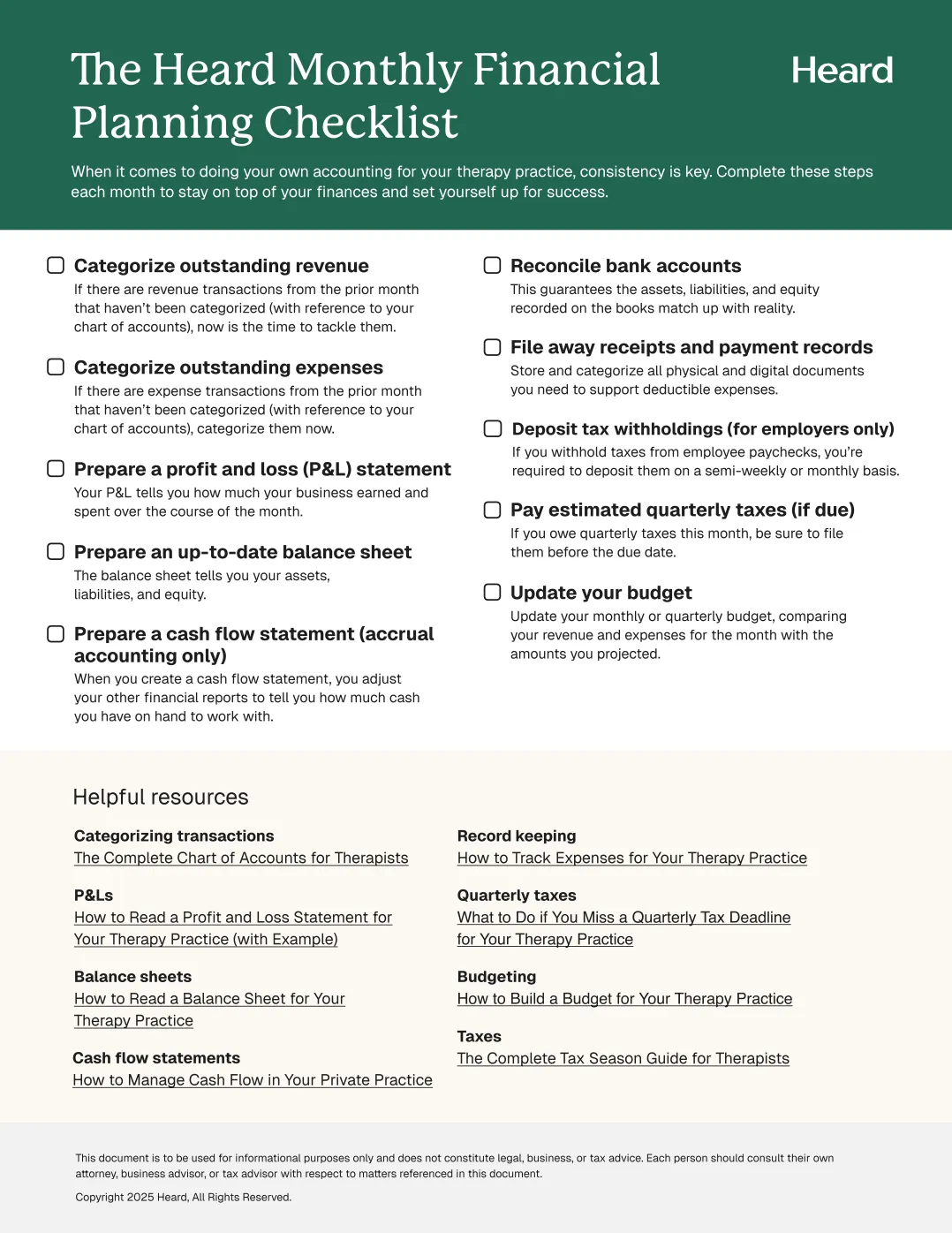Transitioning your therapy practice from insurance to cash pay can help you earn a higher income while freeing up more time and energy to focus on treating your clients.
But many therapists, when they consider depaneling from insurance companies, are stricken with feelings of shame. After all, you’re in the business of helping people. Shouldn’t you be willing to make sacrifices for their sake?
Then there is the actual act of breaking up with your insurance companies. The process isn’t always straightforward, and it can become overwhelming when you’re paneled with many companies.
Finally, your dreams of dropping insurance and moving to cash pay may be stunted by fears of financial uncertainty due to lost clients.
Here’s what you need to know about leaving insurance panels: how to navigate the process, how to prepare financially, how to communicate with clients, and how to approach insurance in a way that puts your practice first.
{{resource}}
Why do therapists stop accepting insurance?
There are three main reasons therapists stop accepting insurance and switch their practices to cash pay:
Low reimbursement rates
According to our 2025 Financial State of Private Practice Report, the average per-session reimbursement for therapists in 2024 was $111.
It’s not unusual for therapists to receive 50% or less of their per-session fee as reimbursements from insurance companies.
Low reimbursement rates can lead to a plateau in your earnings: even once your client list is full, you may find your income barely covers your expenses—with no hopes of improving. Not only does that create financial stress, it can lead to a sense of being undervalued and, eventually, burnout.
Excessive paperwork
The process of filing claims and following up with insurance companies can, in some cases, lead to hours of extra work every week.
That time isn’t paid for by session fees—it comes, in a sense, out of your own pocket. And it’s time you could spend catching up on client notes, marketing your practice, handling any number of back office tasks, or even getting some much-needed R&R.
Difficulty getting reimbursed
As Dr. Brian Dixon said on the Heard Business School podcast, “Insurance companies are companies. Their goal is to make a profit, which means that they want to keep as much of their money as possible.”
It is in an insurance company’s best interest to deny claims whenever possible. That may lead to situations where you struggle to get reimbursed for services you have provided. If those struggles become frequent, they can lead to extra work, extra stress, and lost income.
In the end, you may find that accepting insurance is more trouble than it’s worth.
Is it wrong to stop taking insurance?
If you’re like most therapists, then part of the reason you chose your career was because you wanted to help people.
Many therapists struggle with feelings of guilt and shame when it comes to financial matters. It may seem to you that, by prioritizing your own financial success, you are putting the interests of your clients second.
But if you can’t earn a sustainable income, you won’t be able to cover your expenses and keep running your private practice—the same practice that helps people in need. And even if you can cover expenses, if you’re not adequately compensated for your time with a reasonable income, it can lead to the feeling that you are undervalued. That can contribute to therapist burnout, which impacts your ability to serve your clients.
Finally, in the words of Tracy Vadakumchery, LMHC:
You deserve to give yourself a raise. You can't be making the same pay forever and ever and ever. Eventually your financial needs are going to change over time. So you are allowed to give yourself a raise, especially if you are self-employed. You're allowed to go out of network with insurance at some point. If it no longer works for you, your practice belongs to you. It doesn't belong to anyone else but you.
When should you stop taking insurance?
If you have decided you want to stop taking insurance, but aren’t sure whether the time is right, here are three conditions you should meet before taking the plunge:
- You are confident you can replace clients who leave. As a guideline, assume that 50% of your current clients will leave if you stop taking insurance. In that case, how will you replace them? If you already have a waitlist of potential clients, or if you’re constantly turning down new ones, it may not be a problem. On the other hand, if you have struggled in the past to find new clients, you may need to explore new marketing opportunities before you sacrifice a portion of your current clientele.
- You know your increased earnings from cash pay will help offset the cost of lost clients. Depending on your current reimbursement rates and your per-session fee, it may be that higher earnings from cash pay will help make up for the cost of lost clients. But take the time to do the math and figure out how much you stand to earn even if existing clients leave.
- You have a plan. Don’t move ahead with dropping insurance until you have a plan in place—both for the process of depaneling, and for adapting your practice to cash pay.
{{resource}}
Financial planning for the transition from insurance to cash pay
Dropping insurance will have an impact on your practice’s finances—there’s no way around it. Hopefully, that impact will be positive in the long run. In the short term, though, it may create challenges.
Creating a financial plan increases your likelihood of success. Some key steps:
Set aside emergency funds
If your income dips and you struggle to cover your practice’s expenses—including your salary—be prepared to make up the difference with money from savings.
Set aside enough savings to cover all your expenses for one to three months. The exact amount will depend on your expenses, how much business you expect to lose from switching from insurance to cash pay, and the amount of time you expect you will need to fill up your client list again.
It also depends on your depaneling schedule. If you gradually transition from insurance to cash pay—or if you only plan on dropping one or two particular insurance companies—the switch may have less of an impact on your finances.
Create financial projections
Financial projections model how your business will perform financially depending on various factors.
Create financial projections for the next 12 months that take into account:
- The potential loss of clients (50%) due to dropping insurance
- The potential gains in revenue due to accepting cash pay only
- Emergency savings and how you will use them
- Any changes to your expenses (more on that shortly)
It’s a good idea to create three projections:
- A “worst case scenario” projection, with the biggest dip in income you can realistically anticipate
- A “best case scenario” projection, with the smallest dip in income you can realistically anticipate
- An “average” projection, lying somewhere between best and worst case scenarios
These projections can help you anticipate changes to your practice, model scenarios so you can prepare in advance, and adjust your budget.
Review your expenses
Take time to look over your budget and find ways you can decrease your expenses in the short term.
This could include deferring loan repayments or switching from in-person to remote therapy sessions.
But also take into account any expenses that may increase. For instance, if you plan to ramp up your online marketing in order to attract new clients, factor in the extra cost as part of your marketing budget.
Consider alternative income streams
If you earn income outside of your clinical practice—for instance, from running workshops, supervising, or consulting—then this may be a good time to devote more time to them.
If you don’t have alternative income streams, consider whether there are any opportunities to open one.
When your one-on-one client sessions drop, other income streams can help make up the difference. Just remember to stay flexible, so you can devote time and energy to regular sessions once business picks up again.
Plot your availability
If you anticipate losing clients due to your switch to cash pay, estimate how much time that will free up in your schedule.
This can help you plan how many more clients you are able to take on in order to fill out your list, or how much time you will have available to devote to alternative income streams.
If insurance paperwork takes up a sizable amount of your schedule, don’t forget to take into account the additional time a cash-only practice will free up in your schedule.
Invest in getting new clients
Budget the amount of money and time you will need to spend in order to fill up your client list again.
In terms of your schedule, that could mean meeting with people in your network to let them know about the changes to your practice and to cultivate referrals. It could also mean putting more hours into building up alternative income streams.
In terms of money, it could mean paying for ads on Google or social media, or hiring a part-time social media manager to increase your online presence. Or it could even mean ads in local newspapers, or new signage for your practice’s office.
{{resource}}
How to get off insurance panels for therapists
Each insurance company has its own process for depaneling. But outside of those requirements, the steps for each are generally the same.
Review the companies you’re paneled with
Before starting, double-check your status with each insurance company to confirm that you are paneled with them.
In most cases, you can do this by going to the company’s website, accessing their provider search tool, and entering your NPI 1. (Your NPI 1 is the number insurance companies use to identify you. For more info, check out The Complete Guide to Insurance Credentialing for Therapists.)
If your name doesn’t turn up on a search, contact the company directly to determine whether you are paneled with them.
List companies starting with the ones you want to leave soonest
Gradually depaneling from insurance companies can give you more breathing room as you potentially lose clients and adapt your practice to cash pay. But even if you are taking an aggressive approach and plan to drop every insurance company at the same time, start with those you’re most eager to leave.
In most cases, these are the companies that offer the lowest reimbursement rates. But other factors—like difficulty getting reimbursed, or the number of claims you need to file for each insurance company every month—may play a role.
Depaneling from your first insurance company may be intimidating. If it’s a company you especially look forward to dropping, though, you might find yourself more motivated to take the plunge.
Review the contract for each company
Your contract with each company will include:
- The steps you need to go through to depanel
- The delay period between notifying the company and the date at which you are officially depaneled
- Any conditions you’re obligated to fulfill, such as continuing to file claims for clients during the delay period
Keep an eye out for auto-renewal clauses. Some contracts stipulate a date each year when they automatically renew. You may need to take extra steps to prevent your contract from renewing even after you have broken with the insurance company.
Terminate your credentials with an insurance company
To officially end your relationship with an insurance provider, you may be required to:
- Write and submit a letter (by email or post)
- Complete online forms
- Speak directly with a representative
- Any or all of the above
Keep records of the process in case you ever need to prove that you have gone through the required steps. Records may include:
- Copies of letters you have sent
- Copies of correspondence from the insurance company
- Any contracts or agreements you may need to sign
- Your original contract
- Print-outs of of confirmations after completing online forms
- Notes or recordings of phone calls with representatives
- Any written acknowledgements from the company confirming that they have accepted your termination of the contract
Track the delay period
There is typically a delay period between the date when the insurance company acknowledges that you are terminating your relationship with them and the date when the termination comes into effect.
During the delay period, you may be required by the terms of your contract to continue filing claims with the company.
Carefully note the date when your termination comes fully into effect so you don’t run afoul of any of these terms.
Notify your clients
Once the insurance company acknowledges your intent to terminate, communicate with every affected client about the change.
The best way to do this is with a one-on-one conversation with each client. But for your records, and for the sake of having all the necessary information in writing, draft a form letter you can give to each client as well.
Important information to include:
- The official termination date
- Whether you will continue to bill insurance during the delay period
- Whether you will provide out-of-network billing (OON) or superbills for your clients after the termination is complete
- Your per-session fee for cash payment
Some clients may decide to end treatment with you as soon as you stop accepting your insurance. Others may be satisfied with switching to OON billing or superbills. Still others may be willing to pay out of pocket to continue treatment.
Clients may wish to continue treatment but be unable to afford to do so. Put a plan in place to work with each client to find a solution. This solution could take the form of a sliding scale rate, or reduced sessions per month. But it could just as easily consist of plans to refer them to qualified therapists who accept their insurance and who you believe would be a good fit for the client.
Be prepared to answer questions
Have an explanation prepared ahead of time for clients who ask why you are depaneling.
Be honest about your reasons for dropping insurance, even if those reasons include your desire to earn a higher income. But don’t neglect to mention how earning your worth as a therapist helps you to stay in practice and continue serving clients.
{{resource}}
Complete the transition to cash pay
Whether you are transitioning completely from insurance to cash pay, or whether you are only dropping some insurance companies and staying paneled with others, there are some final steps and processes to complete once you’ve made the switch.
Update your website and therapist profiles
As soon as possible, update your personal website and any listings in directories like PsychologyToday to reflect your new insurance policy. That could either entail removing the names of certain insurers or specifying that your practice is cash pay only.
Adapt your onboarding process for new clients
Depending on where you are in your depaneling journey, you will need to change your process for bringing on new clients:
- If you are considering depaneling, but have not officially notified any companies, you are not required to notify new clients of the fact.
- During the delay period between ending your relationship with an insurance company and the official date of your termination, you should plan to inform new clients of the fact (whether or not your contract stipulates that you must do so).
Update your bookkeeping or notify your bookkeeper
Cash pay income is recorded on the books differently from insurance reimbursements. You may need to modify your chart of accounts to reflect the fact.
If you have a professional bookkeeping solution, notify your bookkeeper of the fact that you are switching to cash pay, so they understand how your business has changed and how to accurately categorize transactions.
Key points
- Therapists often switch from insurance to cash pay because of low reimbursement rates, extra paperwork, and difficulty getting reimbursed by insurance companies
- Depaneling from insurance doesn’t make you a bad therapist. To stay in practice and avoid burnout, you need to make sure you’re earning your worth
- Each insurance company has a different process for depaneling. Carefully review your contract before beginning the process
- During the delay between notifying your insurance company and the official date of your termination, you may be required to continue filing claims for clients who are covered
- Communicate clearly with clients when you stop accepting their insurance, and work with them to find a solution so they continue receiving treatment (whether from you or another qualified therapist)
—
Want to learn more about becoming an out-of-network provider? Check out our complete guide to out-of-network billing for therapists.
This post is to be used for informational purposes only and does not constitute legal, business, or tax advice. Each person should consult their own attorney, business advisor, or tax advisor with respect to matters referenced in this post.
Bryce Warnes is a West Coast writer specializing in small business finances.
{{cta}}
Manage your bookkeeping, taxes, and payroll—all in one place.

Discover more. Get our newsletter.
Get free articles, guides, and tools developed by our experts to help you understand and manage your private practice finances.





